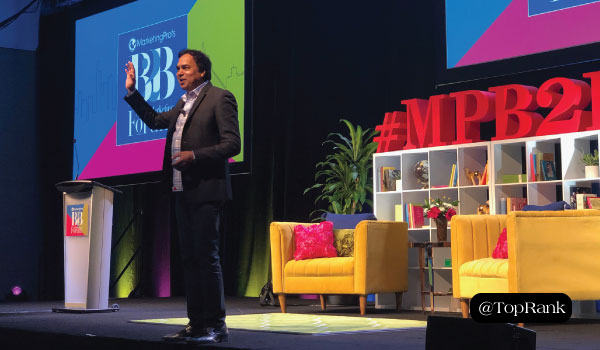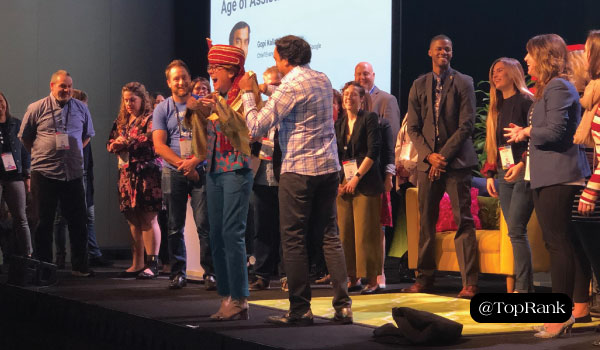
One of the key themes for this year’s MarketingProfs B2B Forum is the importance of ongoing learning. And part of learning is growing. And part of growing means stepping outside of your comfort zone.
Gopi Kallayil, the Chief Evangelist for Brand Marketing at Google opened his morning keynote by encouraging the audience to do things that make you uncomfortable. And to prove his point, he involved the ENTIRE audience. How?
He started by asking the audience to raise their hand if they were either a fan of or expert Bollywood dancers themselves. Then, he asked all those people to join him on stage. Here’s proof that it worked:

After everyone reached the stage he informed the rest of the audience sitting down, that it was their job to judge the group on their dancing skills. This is when he flipped the script and engaged the entire audience in a 5 minute Bollywood dance lesson. And even though I am a bad (if not terrible) dancer myself, it was a fun and engaging experience.
“People learn best when they’re having fun.” @GopiKallayil #MPB2B Click To TweetHow can the same lesson be applied to our everyday lives?
Consumers are Glued to Their Mobile-Devices
Not only are we all glued to our mobile devices, but we now expect them not just to give information, but to complete actions. To prove his point, Gopi asked his Google phone to complete a simple command: “Play Bollywood dance music.”
It only took his phone approximately four seconds to find and start playing music, but believe it or not, it seemed like an eternity. Something that wasn’t even possible three years ago now seemed inefficient.
Our connection to our devices is changing consumer expectations of all brands and creating some major cultural shifts along the way.
Would You Get in a Car with a Stranger?
Ten years ago, everyone would respond with a strong and resounding “NO!”. But if you ask the average person today, they jump into a stranger’s car at least a few times a month.
Brands like Uber and Lyft have completely changed the narrative and stigma about riding with strangers. The technology behind brands like these has created a series of safety checks and balances to put consumers’ minds at ease.
And this is where the lines begin to blur. Because consumers have a ride, plane ticket or pizza at their fingertips, their expectations have evolved.
3 Major Changes in Customer Expectations
Curiosity
At our core, humans are curious creatures. And this curiosity impacts how we search for things. Now if someone told you they spent weeks researching and gathering data to make a decision about a large purchase like a house or a car, you wouldn’t think twice.
But now, a comparable amount of time is spent researching something as simple as buying a new toothbrush. Gopi shared that searches for “best toothbrush” have increased 100% in the past year. And many of the videos on YouTube have over 10million views.
The world isn’t suddenly interested in better oral hygiene, it’s that the information is available. When you remove the friction associated with content access, customers will consume.
Demand
Let’s face it, we’re all becoming more demanding. Each technological advance carves a path for our how expectations change.
One of the biggest factors to consider is that our customers are on the move and want instant access from their phone. That could include using voice search to find a nearby store or searching for some mobile-friendly B2B content to read on their morning walk to work.
Impatience
A recent study by Neil Patel showed that if a webpage takes more than 3 seconds to load on a mobile device, half of your customers will abandon your site and move on.
Gopi provided a great analogy that applies to B2B and B2C marketers alike:
If your website takes more than 3 seconds to load, it’s like you took all of this effort to market your product and bring customers to the door. And the door is jammed. @GopiKallayil #MPB2B Click To TweetEach brand should think about the digital experience that they offer. We often assign value to a contact request, time on page or number of pages viewed. Additionally, B2B marketers should start to calculate how much every extra second of load time is costing your business or your client’s business.
3 Characteristics of Brands Driving Growth
Organizations that are successfully reducing friction and providing assistance are implementing the following three tactics.
Show Up
As marketers, it’s our job to know where our customers are in the lifecycle with our product or service. We should continually ask ourselves:
Am I showing up in front of my customers in those moments in a non-intrusive way and being of assistance?
Today’s customer requires that we show up in front of them and offer assistance. Below are two examples of brands showing up for their customers:
Speed Up
Speed is an enormous point of friction for many customers as we discussed early. Slow load times lead to abandonment. Gopi recommended each brand run the following test:
- Pull out your mobile device
- Turn off your wifi
- Enter your brand’s website URL
- Hit load and count how many seconds it takes for your website to load
What was the result?
Another tool you can use is Google’s Test My Site. The tool will run some diagnostic tests and share an average load speed and estimated percentage for loss of visitors due to slow load speeds.
Wise Up
Marketers MUST start to look at each of our customers as individuals. This means customizing your marketing campaigns to their location, preferences and even the weather. That way you can meet immediate needs.
Keep in mind that personalization applies just as much to B2B marketing as it does to B2C. The customers purchasing B2B platforms or services are people with specific preferences and needs. Get to know what they are.
Go-Forth & Assist Your Customers
While a lot of the examples included in Gopi’s presentation showcased how B2C companies are meeting customer needs, the same rules apply for B2B marketers. As you work through your upcoming marketing plans, keep the following question top of mind:
How am I assisting my customers?


